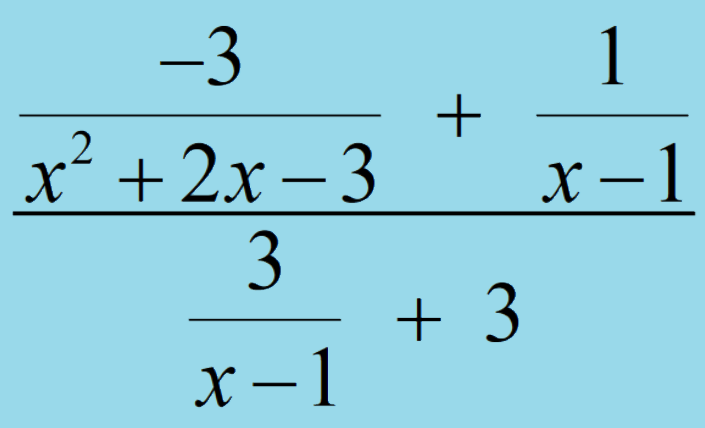A1.6 Quadratics

This module looks at algebraic fractions where the denominator is a quadratic expression. Such fractions are common in mathematics and engineering.
More complicated algebraic fractions can involve polynomials of any order.
However in your studies, it is unlikely that you will have to deal with polynomials higher than quadratics. 1 A quadratic is a a polynomial of degree 2 and has the general form: \[\begin{align*} ax^{2}+bx & +c \end{align*}\] where \(a,b,c\) are constants.
In this module, we consider algebraic fractions involving quadratics.
There is no general theory for this so we proceed via examples. Please note that algebraic fraction may exclude certain values of \(x.\) This is to ensure we never get a zero denominator. 2 The numerator is the top expression in the fraction. For \[\begin{align*} \frac{a}{b} \end{align*}\] \(a\) is the numerator. The bottom expression is called the denominator. Here \(b\) is the denominator.
The concept of a common denominator is fundamental to algebraic fractions.3 Before you can add or subtract two fractions you need to have a common denominator. For example, to determine \[\begin{align*} \frac{2}{3}-\frac{1}{2} \end{align*}\] we have to convert each fraction into sixths as a common multiple of \(3\) and \(2\) is \(6\). Therefore \[\begin{align*} \frac{2}{3}-\frac{1}{2} & =\frac{4}{6}-\frac{3}{6}\\ & =\frac{4-3}{6}\\ & =\frac{1}{6}. \end{align*}\] The same concept is necessary for algebraic fractions.
Example 1
Determine \[\begin{align*} \frac{2}{x^{2}+x-12}-\frac{1}{x^{2}-9}. \end{align*}\]
Solution:
You could use \(\left(x^{2}+x-12\right)\times\left(x^{2}-9\right)\) as a common denominator and work from there. However, that would give you a quartic as a denominator which may be a bit difficult to reduce to lowest terms.
4 A quartic is a polynomial with highest term of degree \(4\). That is a term involving \(x^{4}.\)
Instead we note that the denominators may be factorised. In particular, \[\begin{align*}
x^{2}+x-12 & =\left(x+4\right)\left(x-3\right)
\end{align*}\] and \[\begin{align*}
x^{2}-9 & =\left(x-3\right)\left(x+3\right).
\end{align*}\] So we can write \[\begin{align*}
\frac{2}{x^{2}+x-12}-\frac{1}{x^{2}-9} & =\frac{2}{\left(x+4\right)\left(x-3\right)}-\frac{1}{\left(x-3\right)\left(x+3\right)}.
\end{align*}\] A common denominator is \[\begin{align*}
\left(x+4\right)\left(x-3\right)\left(x+3\right)
\end{align*}\] so \[\begin{align*}
\frac{2}{x^{2}+x-12}-\frac{1}{x^{2}-9} & =\frac{2\left(x+3\right)}{\left(x+4\right)\left(x-3\right)\left(x+3\right)}-\frac{1\left(x+4\right)}{\left(x-3\right)\left(x+3\right)\left(x+4\right)}\\
& =\frac{2\left(x+3\right)-1\left(x+4\right)}{\left(x+4\right)\left(x-3\right)\left(x+3\right)}\\
& =\frac{2x+6-x-4}{\left(x+4\right)\left(x-3\right)\left(x+3\right)}\\
& =\frac{x+2}{\left(x+4\right)\left(x-3\right)\left(x+3\right)}\text{ where $x\neq-4,-3,3$ }.
\end{align*}\]
Example 2
Simplify \[\begin{align*} \frac{1-\frac{2}{x}}{1+\frac{2}{x}}. \end{align*}\]
Solution:
\[\begin{align*} \frac{1-\frac{2}{x}}{1+\frac{2}{x}} & =\left(1-\frac{2}{x}\right)\div\left(1+\frac{2}{x}\right)\\ & =\frac{x-2}{x}\div\frac{x+2}{x}\\ & =\frac{x-2}{x}\times\frac{x}{x+2}\\ & =\frac{x-2}{x+2}\text{ where $x\neq-2$ .} \end{align*}\]
Example 3
Simplify \[\begin{align*} \frac{\frac{-3}{x^{2}+2x-3}+\frac{1}{x-1}}{\frac{3}{x-1}+3}. & & \left(3.1\right) \end{align*}\]
Solution:
The numerator is: \[\begin{align*} \frac{-3}{x^{2}+2x-3}+\frac{1}{x-1} & =\frac{-3}{\left(x+3\right)\left(x-1\right)}+\frac{1}{x-1}\\ & =\frac{-3}{\left(x+3\right)\left(x-1\right)}+\frac{1}{x-1}. \end{align*}\] Using a common denominator, we have \[\begin{align*} \frac{-3}{x^{2}+2x-3}+\frac{1}{x-1} & =\frac{-3}{\left(x+3\right)\left(x-1\right)}+\frac{1}{x-1}\\ & =\frac{-3}{\left(x+3\right)\left(x-1\right)}+\frac{\left(x+3\right)}{\left(x+3\right)\left(x-1\right)}\\ & =\frac{x}{\left(x+3\right)\left(x-1\right)}. & \left(3.2\right) \end{align*}\]
Now consider the denominator of eqn\(\left(3.1\right)\): \[\begin{align*} \frac{3}{x-1}+3 & =\frac{3}{x-1}+\frac{3\left(x-1\right)}{x-1}\\ & =\frac{3x}{x-1}. & \left(3.3\right) \end{align*}\] Using eqns \(\left(3.2\right)\) and \(\left(3.3\right)\)
\[\begin{align*} \frac{\frac{-3}{x^{2}+2x-3}+\frac{1}{x-1}}{\frac{3}{x-1}+3} & =\frac{x}{\left(x+3\right)\left(x-1\right)}\div\frac{3x}{x-1}\\ & =\frac{x}{\left(x+3\right)\left(x-1\right)}\times\frac{\left(x-1\right)}{3x}\\ & =\frac{x}{3x\left(x+3\right)}\\ & =\frac{1}{3\left(x+3\right)}\text{ where $x\neq-3.$ } \end{align*}\]
Exercises
Simplify the following:
\(1.\) \[\begin{align*} \frac{2}{x^{2}+2x}+\frac{1}{x^{2}-4} \end{align*}\]
\(2.\) \[\begin{align*} \frac{1-\frac{6}{x}}{\frac{x}{2}-3} \end{align*}\]
\(3.\) \[\begin{align*} \frac{\frac{1}{x^{2}-4}+\frac{1}{2x+4}}{1+\frac{2}{x-2}} \end{align*}\]
\(1.\)
\[\begin{align*} \frac{3x-4}{x\left(x+2\right)\left(x-2\right)} & \text{ where $x\neq-2,0,2$ }. \end{align*}\]
\(2.\) \[\begin{align*} \frac{2}{x} & \text{ where $x\neq0$ }. \end{align*}\]
\(3.\) \[\begin{align*} \frac{1}{2\left(x+2\right)} & \text{ where $x\neq-2$ }. \end{align*}\]
Download this page, A1.6 Algebraic Fractions - Quadratics (PDF 142KB)
What's next... Partial fractions
